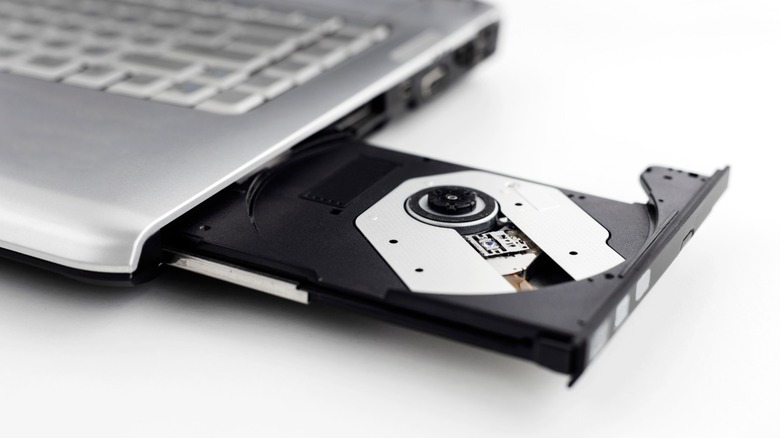When Did Laptops Get Rid Of CD/DVD Drives?
If you used or owned a laptop in the 2000s, you'd probably remember that it sported either a DVD or Blu-Ray drive for popping in installation discs, movies, and even the occasional album from your favorite artist. But fast forward to today, and it will likely take a miracle to find a brand-new option with a built-in optical drive on Amazon and other retailers. So, what happened in between, and when did this trend start?
Well, the advent of USB drives and faster internet seems to have hastened the demise of the built-in drive. The Asus Eee PC netbook was one of the first popular models to ditch optical discs. It launched in 2007 and was quite popular among users who needed a compact computer for basic productivity and internet browsing, though the company eventually gave in to demand and introduced a model with an optical drive in 2009. Apple also released the ultra-thin MacBook Air in 2008, one of the most iconic Apple devices ever made, which it achieved partly by omitting the internal SuperDrive found on other MacBooks.
Laptops with disc drives did not entirely disappear — in fact, Fujitsu just released a high-end laptop with a Blu-ray drive in Japan. But four years after the MacBook Air's debut, Apple rolled out the last laptop that would feature a DVD drive — the mid-2012 13-inch MacBook Pro. Other manufacturers would soon follow suit, and you would have found that this once common feature was now a rarity by the mid- to late-2010s.
What made the optical drive disappear?
Faster broadband internet and advancements in storage technology, such as flash drives, hard drives, and SSDs, mean users have a cheaper, more reliable alternative for data sharing. After all, you can drop a flash drive on concrete and not worry about losing your data, but if you scratch up the surface of your DVD or Blu-ray, you might render it unreadable. Furthermore, the advent of stable, high-bandwidth internet meant you no longer needed to burn your data to a CD/DVD and meet up with someone just to share your files — instead, you can simply send them via email or cloud storage.
These technological breakthroughs also made backup much easier. You no longer need to regularly burn all your files on a disc; you can just sign up for a Google Drive subscription, and it will automatically sync your files to a remote server to help safeguard your information. Storage drives are also now much cheaper, making them a faster, more convenient, and cost-effective alternative for backing up your data locally. This meant that those who must protect their digital assets no longer had to choose between NAS and Cloud Storage — they could use both without spending a fortune to implement the 3-2-1 data backup strategy (three copies of your data on two different types of media, with one stored off-site).
The omission of optical drives from laptops made them cheaper and sleeker. After all, PC manufacturers save a few dollars by omitting that component, passing some of those savings on to consumers. Aside from that, DVD and Blu-ray discs are relatively large, so replacing them with circuitry for other components, like SSDs, can give you far more high-speed storage, easily accessible right on your PC.

